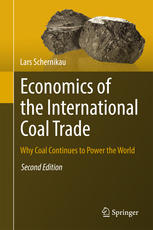

Most ebook files are in PDF format, so you can easily read them using various software such as Foxit Reader or directly on the Google Chrome browser.
Some ebook files are released by publishers in other formats such as .awz, .mobi, .epub, .fb2, etc. You may need to install specific software to read these formats on mobile/PC, such as Calibre.
Please read the tutorial at this link. https://ebooknice.com/page/post?id=faq
We offer FREE conversion to the popular formats you request; however, this may take some time. Therefore, right after payment, please email us, and we will try to provide the service as quickly as possible.
For some exceptional file formats or broken links (if any), please refrain from opening any disputes. Instead, email us first, and we will try to assist within a maximum of 6 hours.
EbookNice Team

Status:
Available5.0
19 reviewsThis book is the 2nd edition of the Economics of the International Coal Trade. Coal is the single most important source of power on our planet and today accounts for 40% of electricity generation and 30% of primary energy. The world’s appetite for energy is still far from being met. Until 2050, an additional 6+ billion people will require accessto proper power. “Why Coal Continues to Power the World” introduces the reader to the global coal business; its importance; its source; its global demand, supply and trade; its use; its environmental impact; and its future. Despite recent price hikes, coal does not appear to be a popular subject today, which may explain the little attention it receives in the scientific community. Since writing the first edition during the commodity super cycle in 2006–2008, the world has changed. How has this impacted the global world of coal? This book is useful to energy economists, businessmen, politicians, university professors, high school teachers, students and anyone with an interest in how the world is powered. It is also helpful to anyone studying climate change and global warming.
This new edition of the book includes previously not covered special sections on:* Coal analysis and sampling with a special section on moisture
* A technical summary of all key coking coal characteristics in Appendix 2
* Coking coal, iron ore and the steel industry
* Cement and petcoke markets
* Global gas markets and the shale gas revolution in the US
* Nuclear energy and the history of the oil market
* Renewable energy and the German „Energiewende“
* Power plant technology and CO2 sequestration and processing
* The role of CO2 and why man-made CO2 does not cause global warming
Apart from giving an in-depth overview of the global coal business, in this book the author argues that coal is far from “dead”. Some of my key messages are contrary to popular beliefs: